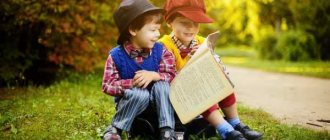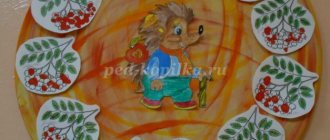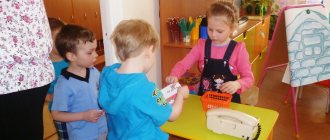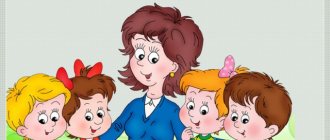MAGAZINE Preschooler.RF
Non-traditional forms of working with children in the organization of educational activities, aimed at the implementation of the Federal State Educational Standards for preschool educationPedagogical article
Author: Irina Viktorovna Nazarenko, Municipal Budgetary Preschool Educational Institution No. 7 “Rainbow”, Altai Territory, Kulundinsky District
teacher Kulunda 2020
Direct educational activities are based on one of the specific children's activities and are carried out jointly with the teacher. This activity is aimed at children mastering one or more educational areas or their integration using a variety of forms and methods of work.
In terms of content, the educational activity itself can be:
Classical - in the old classical form: explanation, completion of the task by children. Results of the lesson.
Combined - a combination of different types of activities or several didactic tasks that do not have logical connections with each other (after drawing there is an outdoor game).
Complex - the implementation of tasks through different types of activities with associative connections between them (a conversation about fire safety rules turns into drawing a poster on the topic). At the same time, one type of activity dominates, and the second complements it and creates an emotional mood.
Integrated – they combine knowledge from different educational fields on an equal basis, complementing each other (considering such a concept as “mood” through works of music, literature, painting), i.e. combine knowledge from several areas. This association is not arbitrary or mechanical. It is necessary to provide for the integration of knowledge in such a way that they complement and enrich each other when solving didactic problems.
Final or test.
This is the traditional classification.
A non-traditional lesson differs from a traditional one: in preparation and conduct; according to the structure of the lesson; on the relationship and distribution of responsibilities between teacher and student; on the selection of educational materials and criteria for their evaluation; according to the methodology for assessing activities.
Many teachers continue to adhere to the structure of a traditional lesson when performing any didactic task, be it the formation of new knowledge or the development of skills. This is explained by the fact that the practical skill of constructing a traditional lesson, developed by teachers over the course of decades, has become a kind of psychological barrier, which can only be overcome by realizing that presentation and consolidation are not the main goal of the teacher and that the lesson can be built on the basis of other goals, according to a different didactic scheme.
The use of non-traditional forms of classes is a powerful stimulus in learning; it is a varied and strong motivation. Through such activities, cognitive interest is activated much more actively and quickly, because the child by nature likes to play. Another reason is that there are many more motives in the game than in ordinary learning activities. Thanks to non-traditional forms of classes, tension is relieved and there is an emotional impact on children, thanks to which they develop stronger, deeper knowledge.
Conducting such classes indicates the attempts of teachers to go beyond the template in building the methodological structure of the educational lesson. Understanding the pedagogical process allows us to identify two main functions of education: the function of transmitting a message, or expressing meaning (teaching educational material according to the program); the function of communication, that is, providing understanding, motivation to action, emotional satisfaction.
Modern teachers carry out the first function relatively easily, having a foundation of special knowledge, methodological literature and recommendations. The functions of ensuring understanding, awakening to learning, and emotional satisfaction within the framework of traditional classes are poorly implemented. Therefore, non-traditional activities compensate for this deficiency.
The significance of such activities is determined, first of all, by the fact that the educational activity itself, aimed in its traditional understanding at the assimilation by the group of students as a whole of the requirements of the educational program, not adequately coupled with creative activity, can, paradoxically, lead to to inhibit the intellectual development of children. Getting used to performing standard tasks aimed at consolidating basic skills that have a single solution and, as a rule, a single predetermined path to achieve it based on some algorithm, children have practically no opportunity to act independently, effectively use and develop their own intellectual potential. On the other hand, solving typical problems alone impoverishes the child’s personality, since in this case the high self-esteem of children and the assessment of their abilities by teachers depends mainly on diligence and diligence and does not take into account the manifestation of a number of individual intellectual qualities, such as invention, quick wit, ability for creative search, logical analysis and synthesis. Thus, one of the main motives for using non-traditional activities is to increase the creative and exploratory activity of children, which is equally important both for pupils whose development corresponds to the age norm or is ahead of it (for the latter, the framework of the standard program is simply too tight), and for children requiring special correctional work, since their developmental delay and, as a consequence, reduced academic performance in most cases are associated precisely with the insufficient development of basic mental functions.
Non-traditional classes have their own order of work:
— The teacher must present the selected material in an interesting, unusual form. Rational alternation of activities involves replacing one type of activity with another. In this case, each new routine moment turns into a kind of rest, active, relieving fatigue caused by previous activity.
- A variety of activities should be used in such a lesson. The tasks should be feasible for children, but not too easy.
- Children should receive emotional satisfaction from the activity.
- The tasks should force children to think, try, make mistakes, and finally find the correct answer.
According to the goals and content of training, the position of the teacher in the educational process, and the nature of his activities, principles, methods and forms of teaching change. In non-traditional teaching, the teacher’s activity changes radically. Now the main task of the teacher is not to “convey” , “present” , “explain” and “show” to the students, but to organize a joint search for a solution to the problem that has arisen before them.
Creative principles help to understand the main thing in a non-traditional activity:
- The principle of an individual approach to students. It requires constructing a lesson taking into account the personal needs of children, creating conditions for the development of their individual inclinations, interests, and inclinations.
- The principle of connection between theory and practice. Requires a closer connection between non-traditional forms of education and regular classes: theoretical and practical material receives additional confirmation.
- The principle of consciousness and activity. It involves creating conditions for the student to become interested in the lesson, creative activity in its preparation and implementation, and satisfaction with its results.
- The principle of selectivity. It involves the selection of forms, methods and means of conducting non-traditional classes, taking into account age and preparedness, and whether they have interests in classes.
- The principle of connection between theory and practice. It involves revealing the practical significance of the knowledge, skills and abilities they acquire in the classroom.
- The principle of voluntary participation in activities. It assumes that children have a specific range of interests, which allows them, among many types of activities, to choose the one that best suits their internal needs.
Guided by such principles, the teacher sets the general direction for pedagogical creativity and focuses on very specific teaching activities: rejection of the template in organizing the lesson, from routine and formalism in its implementation.
It is necessary to maximize the involvement of students in active activities in the classroom, the use of various forms of group work, support for alternativeness, plurality of opinions, and the development of the communication function - as a condition for ensuring understanding, motivation to action, and a feeling of emotional satisfaction.
Forms of conducting non-traditional training sessions:
- Excursion. To the library, studio, post office, field, construction site, school, etc.
- Collective creative activity: collective drawing, collective appliqué, etc.
- Occupation-work: planting onions, cutting plants, planting seeds, etc.
- Activity-game: “Toy store” , “Let’s arrange a room for the doll” . Option: Auction activity “Whoever tells you more about an item buys it,” etc.
- Creative activity: workshop of an artist, folk craftsmen, storyteller, “Workshop of Good Deeds” (crafts made from waste, natural materials, paper crafts using TRIZ elements).
- Activities-gatherings: using folklore material, against the backdrop of work, children sing, make riddles, tell fairy tales, and dance in circles.
- Lesson-fairy tale: the whole lesson is based on the plot of one fairy tale, using music, visual arts, and dramatization.
- The lesson is a press conference: children ask questions to the “cosmonaut” , “traveler” , “fairy tale hero” , and he answers the questions. Then the “Journalists” draw and write down what interests them.
- Landing lesson: emergency assistance. (For example: during drawing, we ask children about what they can’t do or do poorly. Today we will draw it, those who are good at it will help us. Option: a joint activity for children of the older and younger groups (co-creation). Elders, k For example, they make a background, the younger ones draw what they can.
- Commented teaching lesson: the whole group of children is given a task - forming the number “7” . One of the children speaks out loud how he makes up a given number, the rest silently do it; if the speaker makes a mistake, a discussion begins. Or the teacher places pictures on the board, the children comment on the image, and make up a story. There are many options you can come up with.
- Lesson - journey: goal - to develop children's monologue speech. One of the children is a “tour guide” , the rest of the children ask questions. Options: travel through fairy tales, native country, city, republic, to the “Land of Fun Mathematics” , according to the “Red Book” , etc.
- Lesson - experiment: this is a favorite experimental activity for children.
- Activities - drawings - essays: the teacher draws, the children compose stories based on their drawings. Children write a letter - a drawing about an event in kindergarten.
- The activity is a competition: like “What, where, when?” . This is a competition for dreamers, poems, and fairy tales. Sports competitions - competitions.
- Activity – game – school: schools for astronauts, athletes, forest dwellers, school for young pedestrians, etc.
- The activity is a concert.
Despite the variety of such classes, they all must meet some general requirements, the observance of which helps to increase the effectiveness of teaching: the teacher must clearly formulate the topic and purpose of the lesson, each lesson must be teaching, developing and educating, the lesson must be a combination of collective and individual work of students . It is necessary to select the most appropriate teaching methods, taking into account the level of preparedness of children, and also take into account the fact that the learning of educational material must be carried out in the classroom using health-saving technologies.
Thus, non-traditional classes are classes that differ in the organization of activities, in the structure of content, in their use in training
In recent years, interest in non-traditional forms of conducting preschool education classes has increased significantly. This is due to various transformations, the active implementation of various pedagogical innovations, proprietary programs and methodological recommendations into practice.
So, non-traditional activities are extraordinary approaches to learning; these are always holidays when all children are active, when everyone has the opportunity to express themselves in an atmosphere of success. These classes include a wide variety of forms and methods, especially such as problem-based learning, search activities, interdisciplinary and intradisciplinary connections. Tension is relieved, thinking is enlivened, interest in the educational program as a whole is excited and increased.
| Next > |
Types of non-traditional drawing in kindergarten
What is especially valuable about non-traditional methods is that most of them can be done by young children, in contrast to the usual drawing with a brush or felt-tip pens and pencils. For middle-aged children (4-5 years old), more complex techniques are available, which are performed with the help of adults. Children aged 6-7 years can use all non-traditional methods independently.
The following describes various methods for practicing non-standard drawing, as well as recommended ages for children.
Fingergraphy
The simplest and most common method of non-traditional technique is drawing with fingertips. Special finger paints are well suited for this; you can also use gouache or watercolor, after wetting it with water.
All that is required of the child is to dip his finger in the paint and leave a print on the paper. It’s fun to decorate the templates this way (you can print them out or draw them by hand):
- Add leaves to the bare tree;
- On the stem and core - petals;
- For the ladybug, make spots on the back;
- For the New Year tree - toys;
- White spots on the fly agaric cap;
- Butterflies have spots on their wings.
Note! Any picture can be fully colored using fingerprinting or the missing elements can be added.
Drawing with palms
This method can be considered the next step after finger painting. The entire palm will be involved here. The same paints can be used as for fingerprinting. Here are some options for drawing with your palms:
- Chick. You should apply yellow paint to your palm and leave an imprint on the paper - you get a body. Then apply paint to the fist and thus make a head for the chicken. All that remains is to add the beak, legs and eyes.
- Fish. To do this, you can apply different colors to your palm, then leave an imprint on the paper and add eyes and fins to the image.
- Tree. To do this, use brown or black palm print paint. Then decorate the resulting tree with leaves using fingerprinting.
- Peacock. This beautiful bird will come from two or more handprints. Then you should draw the head, paws, eyes and decorate the tail.
- Flower. It is worth using bright paint to leave an imprint. Then add a stem with leaves to it.
Cockerel made from a palm print
Note! The open palm most closely resembles a bird. Therefore, using this technique you can make any bird of your child’s choice.
Drawing with cotton swabs (poking method)
This method is reminiscent of fingerprinting, but it uses an alternative tool for making a print - a cotton swab. The mark it makes is small and more round, so this method is good for drawing spots on animals. Another option is to completely paint the image with pokes, thus obtaining a mosaic effect. Using cotton swabs you can draw the following:
- Grains from a mouse or chicken;
- Rowan berries;
- Snowfall;
- Rain;
- Starry sky.
Middle group project “My Family”: GCD lesson plan
You can also use a few pokes to create an object of the required shape, for example, tree leaves or flowers.
Note! You can draw with several sticks at once; for convenience, they can be secured with a string.
Drawing with bulk substances
For this method, you can use salt, sand or any cereal. Drawing occurs in stages. First, you should put some design on the paper. Then drop PVA glue into certain places and sprinkle them with salt or cereal. After drying, shake off excess. The result will be an unusual three-dimensional drawing. You can experiment with this method of drawing on the following topics:
- Winter forest;
- Fireworks;
- Snowstorm;
- Pattern on butterfly wings;
- Flowers.
Snow-covered birch tree made with salt
Note! It is more interesting and colorful to use colored grains or sand. To do this, you can use food coloring or buy ready-made colored sand.
Drawing with crumpled paper
For this method it is more convenient to use gouache. You will need a small piece of paper that needs to be crumpled. Then dip this lump in paint (if necessary, add water to the gouache) and begin to apply it to the paper. The drawing turns out airy and light. Here are some ideas of what you can draw this way:
- Lilac branches;
- Dandelions;
- Clouds;
- Snowy spruce trees;
- Blooming meadow.
Lilac branches
Note! In this way you can color the image in an unconventional way. For example, make a shaggy cat or a fluffy owl.
Drawing with threads in kindergarten
Thread drawing can be a little challenging for preschoolers, so it is recommended to do it with older groups. This is a rather complicated technique and little ones cannot cope with it. To create such a pattern, you need to prepare threads (it is advisable to choose thicker ones, for example, wool). Next, you need to cut a thread about 30 cm long and dip it thoroughly in paint. Then you should place the thread on the paper, for example in a loop, and pull it down. For convenience, you can use two sheets of paper to properly press the thread on both sides. Another option is to fold the sheet in half and thread the thread inside. You can create a variety of patterns, for example:
- Abstraction;
- Flowers;
- Snail (the thread for this should be folded into a spiral);
- Butterfly.
Note! Nitography is the most complex drawing technique for children. But the result is very unusual, and the creation process is interesting and will appeal not only to children, but also to adults.
Monotype
This is a technique of creating an image using a print. A suitable method for kindergarten is when a sheet of paper is folded in half and an image is painted on one side. The design is then pressed onto the other half of the sheet, thus creating a symmetrical image. What can you depict using this technique by drawing only half of the image?
- Butterfly;
- Reflection in the water of the landscape;
- Ship with reflection;
- Vase with flowers;
- Sun;
- Tree.
Landscape with reflection using monotype technique
Note! Monotype is interesting because its result can be unpredictable. The resulting drawing always comes out unique.
Drawing with foam rubber in kindergarten
The execution process and the result are ultimately similar to drawing with crumpled paper. For this technique you will need a piece of foam rubber or a dishwashing sponge. Foam rubber does not need to be soaked in water; it should be immediately dipped in paint. Ideas for images using this technique:
- Snowman;
- Christmas trees;
- Tree crown;
- Winter in the forest.
Landscape painted with foam rubber
Using this technique, you can paint animals, then they will look fluffy.
Blotography
The essence of this method is to initially drop paint onto a piece of paper, forming a blot. Then you should supplement it with various details, obtaining some kind of drawing. This method perfectly develops children's imagination.
To get blots or splashes of paint on paper, you can use a cocktail straw. Using the same tube, you can inflate the blot, obtaining the desired image, for example, the following:
- Tree branches;
- The man's hairstyle;
- Any character.
Note! You can supplement the image with the same paints or felt-tip pens, or even plasticine.
Drawing with wax crayons
Wax crayon can be replaced with a paraffin candle. The essence of this technique is that with the help of a chalk you can draw any design, which will then not be painted over with watercolors and will appear on the surface. Examples of possible images:
- Fireworks in the night sky;
- Sea bottom;
- Cloudy sky;
- Stained glass.
Open mathematical classes in secondary groups according to the Federal State Educational Standard
Note! If you use white chalk, you can make a secret drawing or note, since the image on the paper will appear only after using paint.
"Secret" image
Spray
Creating an image using this technique involves splashing paint onto paper. To do this, you can use a toothbrush or a hard brush. In this case, the splashes are small and distributed chaotically. Therefore, it is better to use stencils to obtain a drawing of the desired shape. This could be a stencil:
- Christmas trees;
- Cat;
- Colors;
- Tree.
Note! In addition, with the help of spraying you can fill in the background of the future drawing. It could be grass, starry sky, snowfall.
Drawing on wet
In this method, paint is applied to a damp surface. As a result, you can get a blurred background for your future drawing. At the preparatory stage, it is better to mark the future drawing with a pencil on a sheet of paper. This should be done before you need to wet it with water. Do not wet it too much; excess water should be removed with a sponge. Watercolor on wet paper will spread evenly from the brush. This way you can let the different colors mix on their own, so the color transition will look even. What can you draw on the raw side, except for a plain background:
- Setting sun in the sky;
- Clouds and storm clouds;
- Flowers;
- Trees;
- Sea bottom.
Note! After the background has dried, you can add any details to the drawing: birds, fish or an outline.
Batik
This is a technique of painting on fabric. For this activity you will need a piece of white cotton material. For kindergarten, the simplest painting option is suitable - knotted. To do this, you need to tie several knots on the fabric, then dip them in paint. After drying, the knots should be untied - interesting patterns will remain on the fabric.
Drawing with traffic jams in kindergarten
Balsa wood stoppers are great for making circular impressions on paper. It is better to take several corks so that you can use each one for a different color of paint and do not mix them. Using this technique you can draw:
- Berries;
- Caterpillar;
- Chickens;
- Leaves;
- Flowers.
Note! If you cut the cork, you can give the prints a different shape.
Stamping
This technique is quite simple to implement and is suitable even for younger kindergarten groups. The idea is to dip a stamp in paint and leave an imprint on the paper. Moreover, you can choose anything as a stamp, for example, the following:
- Leaves;
- Vegetables;
- Fruits;
- Twigs.
Note! It is very convenient to cut stamps of various shapes from potatoes. You can also make stamps from foam sponge.
Ebru
The Ebru technique involves painting with liquid paints on water. Paint and water have different densities, so you can make some kind of pattern on the surface of the water. Then a sheet of paper or cloth is applied to the surface, and the design is transferred to the new surface. Water can be made more dense with a special solution, which is sold in an art store. Thanks to this, the paint does not dissolve in water, but remains on the surface in the form of a film. You can drip the paint onto the water and then use a stick to make patterns.
This technique is suitable for older groups of kindergarten or lower grades of school. Exercises with ebru can be turned into a fabulous game. Children of all ages really like this technique. Without any special skills, already in the first lesson you can feel like an ebru master.
Drawing on water using the ebru technique




